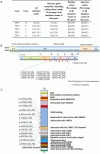Frequent mutations in EGFR, KRAS and TP53 genes in human lung cancer tumors detected by ion torrent DNA sequencing
- PMID: 24760004
- PMCID: PMC3997391
- DOI: 10.1371/journal.pone.0095228
Frequent mutations in EGFR, KRAS and TP53 genes in human lung cancer tumors detected by ion torrent DNA sequencing
Abstract
Lung cancer is the most common malignancy and the leading cause of cancer deaths worldwide. While smoking is by far the leading cause of lung cancer, other environmental and genetic factors influence the development and progression of the cancer. Since unique mutations patterns have been observed in individual cancer samples, identification and characterization of the distinctive lung cancer molecular profile is essential for developing more effective, tailored therapies. Until recently, personalized DNA sequencing to identify genetic mutations in cancer was impractical and expensive. The recent technological advancements in next-generation DNA sequencing, such as the semiconductor-based Ion Torrent sequencing platform, has made DNA sequencing cost and time effective with more reliable results. Using the Ion Torrent Ampliseq Cancer Panel, we sequenced 737 loci from 45 cancer-related genes to identify genetic mutations in 76 human lung cancer samples. The sequencing analysis revealed missense mutations in KRAS, EGFR, and TP53 genes in the breast cancer samples of various histologic types. Thus, this study demonstrates the necessity of sequencing individual human cancers in order to develop personalized drugs or combination therapies to effectively target individual, breast cancer-specific mutations.
Conflict of interest statement
Figures




Similar articles
-
PIK3CA and TP53 gene mutations in human breast cancer tumors frequently detected by ion torrent DNA sequencing.PLoS One. 2014 Jun 11;9(6):e99306. doi: 10.1371/journal.pone.0099306. eCollection 2014. PLoS One. 2014. PMID: 24918944 Free PMC article.
-
Analysis of EGFR, KRAS and P53 mutations in lung cancer using cells in the curette lavage fluid obtained by bronchoscopy.Lung Cancer. 2012 Dec;78(3):201-6. doi: 10.1016/j.lungcan.2012.08.014. Epub 2012 Sep 29. Lung Cancer. 2012. PMID: 23026641
-
Using whole genome amplification (WGA) of low-volume biopsies to assess the prognostic role of EGFR, KRAS, p53, and CMET mutations in advanced-stage non-small cell lung cancer (NSCLC).J Thorac Oncol. 2009 Jan;4(1):12-21. doi: 10.1097/JTO.0b013e3181913e28. J Thorac Oncol. 2009. PMID: 19096301
-
Personalized medicine in non-small-cell lung cancer: is KRAS a useful marker in selecting patients for epidermal growth factor receptor-targeted therapy?J Clin Oncol. 2010 Nov 1;28(31):4769-77. doi: 10.1200/JCO.2009.27.4365. Epub 2010 Oct 4. J Clin Oncol. 2010. PMID: 20921461 Review.
-
Molecular mechanism of genetic, epigenetic, and metabolic alteration in lung cancer.Med Oncol. 2025 Feb 2;42(3):61. doi: 10.1007/s12032-025-02608-5. Med Oncol. 2025. PMID: 39893601 Review.
Cited by
-
p53 Genetics and Biology in Lung Carcinomas: Insights, Implications and Clinical Applications.Biomedicines. 2024 Jun 29;12(7):1453. doi: 10.3390/biomedicines12071453. Biomedicines. 2024. PMID: 39062026 Free PMC article. Review.
-
Frequency of Somatic TP53 Mutations in Combination with Known Pathogenic Mutations in Colon Adenocarcinoma, Non-Small Cell Lung Carcinoma, and Gliomas as Identified by Next-Generation Sequencing.Neoplasia. 2018 Mar;20(3):256-262. doi: 10.1016/j.neo.2017.12.005. Epub 2018 Feb 16. Neoplasia. 2018. PMID: 29454261 Free PMC article.
-
Bixin protects mice against ventilation-induced lung injury in an NRF2-dependent manner.Sci Rep. 2016 Jan 5;6:18760. doi: 10.1038/srep18760. Sci Rep. 2016. PMID: 26729554 Free PMC article.
-
Elevated expression of CRYAB predicts unfavorable prognosis in non-small cell lung cancer.Med Oncol. 2014 Aug;31(8):142. doi: 10.1007/s12032-014-0142-1. Epub 2014 Jul 22. Med Oncol. 2014. PMID: 25048725
-
Circulating Tumor DNA Detection in Early-Stage Non-Small Cell Lung Cancer Patients by Targeted Sequencing.Sci Rep. 2016 Aug 24;6:31985. doi: 10.1038/srep31985. Sci Rep. 2016. PMID: 27555497 Free PMC article.
References
-
- Ferlay J, Shin HR, Bray F, Forman D, Mathers C, et al. (2010) Estimates of worldwide burden of cancer in 2008: GLOBOCAN 2008. Int J Cancer 127: 2893–2917. - PubMed
-
- Bray F, Ren JS, Masuyer E, Ferlay J (2013) Global estimates of cancer prevalence for 27 sites in the adult population in 2008. Int J Cancer 132: 1133–1145. - PubMed
-
- Hecht SS (2003) Tobacco carcinogens, their biomarkers and tobacco-induced cancer. Nat Rev Cancer 3: 733–744. - PubMed
Publication types
MeSH terms
Substances
Grants and funding
LinkOut - more resources
Full Text Sources
Other Literature Sources
Medical
Research Materials
Miscellaneous

